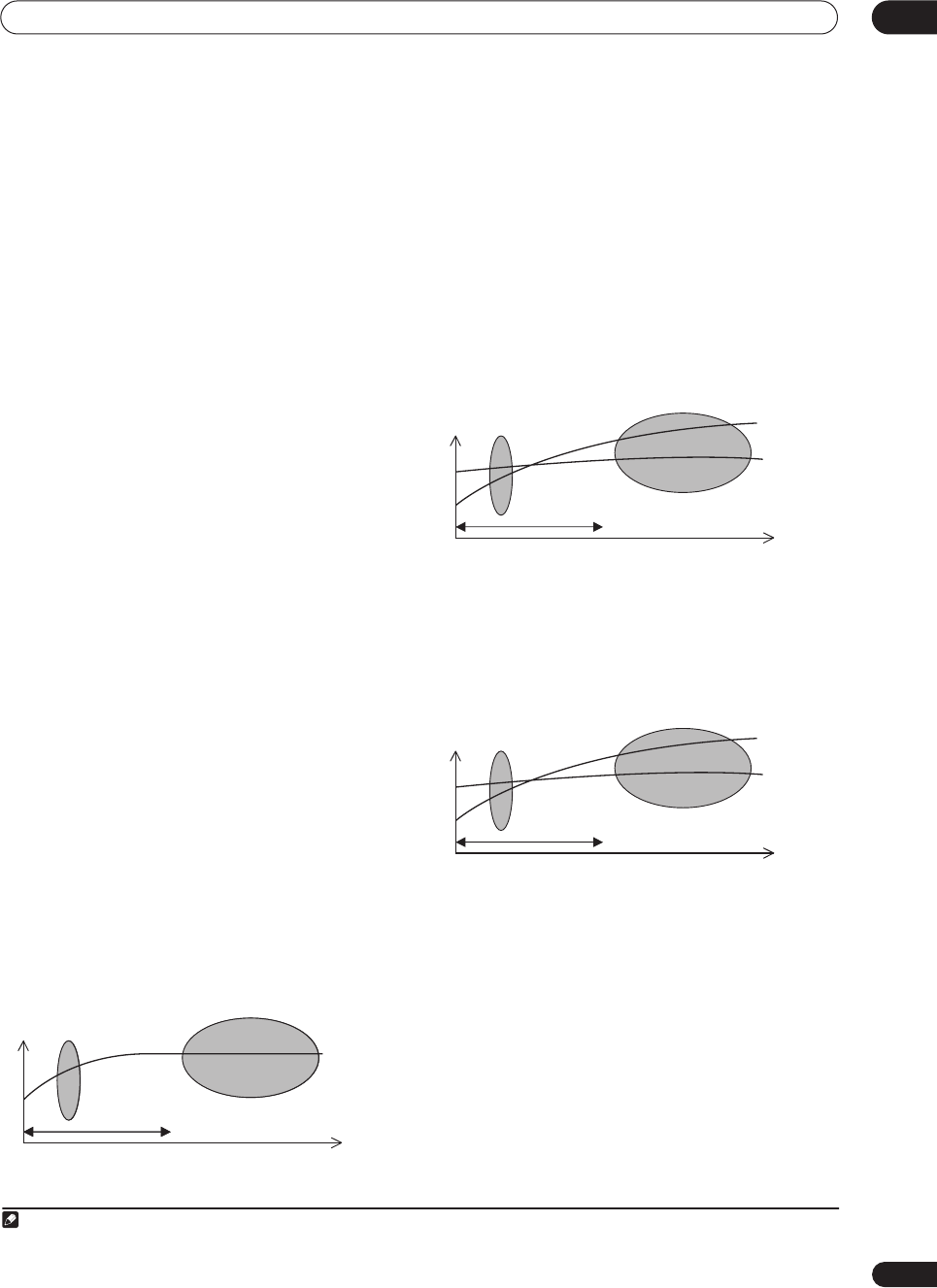
The System Setup menu
07
39
En
How to use Professional Acoustic Calibration EQ
If you find that lower frequencies seem overly reverberant
in your listening room (i.e. it sounds `boomy'), or that
different channels seem to exhibit different reverb
characteristics, select
Aco Cal EQ Pro.
(or
ALL
) for the
Auto Mode
setting in
Automatic MCACC (Expert)
on
page 33 to calibrate the room automatically. This should
provide a balanced calibration that suits the
characteristics of your listening room.
If you still aren't satisfied with the results, the manual
Advanced EQ setup (below) provides a more customized
calibration of your system using the direct sound of the
speakers. This is done with the help of a graphical output
that can be displayed on-screen, or using a computer
(with software available from Pioneer — see
Connecting
a PC for Advanced MCACC output
on page 59).
How to interpret the graphical output
The graph shows decibels on the vertical axis and time
(in milliseconds) on the horizontal axis. A straight line
indicates a flat-response room (no reverb), whereas a
sloping line indicates the presence of reverberation when
outputting test tones. The sloping line will eventually
flatten out when the reverberant sound stabilizes (this
usually takes about 100ms or so).
By analyzing the graph, you should be able to see how
your room is responding to certain frequencies.
Differences in channel level and speaker distance are
taken into account automatically (compensation is
provided for comparison purposes), and the frequency
measurements can be examined both with and without
the equalization performed by this receiver.
1
Setting Professional Acoustic Calibration EQ
according to your room characteristics
Using the manual setup, you can set the time period at
which the frequency response is analyzed, pinpointing
the time that is best for system calibration with your
particular room characteristics.
The graph below shows the difference between standard
acoustic calibration and professional calibration (the
gray circles represent the point at which the microphone
captures the sound for frequency analysis).
As soon as audio is output from your speaker system, it
is influenced by room characteristics, such as walls,
furniture, and the dimensions of the room. The sooner
the frequency analysis, the less it is influenced by the
room. We recommend an earlier time setting of 20–40ms
to compensate for two major factors that will influence
the sound of most rooms:
•
Reverberance of high vs. low frequencies
–
Depending on your room, you may find that lower
frequencies seem overly reverberant compared to
higher frequencies (i.e. your room sounds ‘boomy’).
This may result in a skewed frequency analysis if the
measurement is done too late.
•
Reverb characteristics for different channels
–
Reverb characteristics can be somewhat different for
each channel. Since this difference increases as the
sound is influenced by the various room
characteristics, it is often better to capture a
frequency analysis early on for smoother mixing of
channel frequencies/sounds.
If your room isn’t affected by the factors above, it is often
not necessary to make a 20–40ms setting. Later time
settings may provide a more detailed sound experience
with your speaker system. It is best to try and see what
works best for your particular room.
Note that changing the room (for example, moving
furniture or paintings) will affect the calibration results.
In such cases, you should recalibrate your system.
Note
1 Note that due to an effect known as ‘group delay’, lower frequencies will take longer to be generated than higher frequencies (this is most obvious when
comparing the frequencies at 0ms). This initial slope is not a problem (i.e. excessive reverb) with your listening room.
0 16080
Test tone
Time
(in msec.)
Level
Acoustic Cal. EQ Pro
calibration range
Standard Acoustic Cal.
EQ calibration range
0 16080
Low
frequencies
High
frequencies
Time
(in msec.)
Level
Acoustic Cal. EQ Pro
calibration range
Standard Acoustic Cal.
EQ calibration range
0 16080
Left
surround
Right
Surround
Time
(in msec.)
Level
Acoustic Cal. EQ Pro
calibration range
Standard Acoustic Cal.
EQ calibration range
VSX_AX4AVi_G.book.fm 39 ページ 2005年7月6日 水曜日 午後4時12分


















